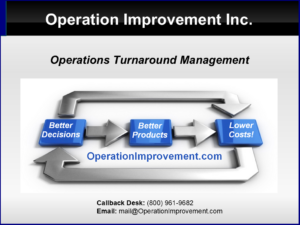Division of Labor in Decision Making
“Organizing Operations”
James Abbott devoted considerable time studying policy, strategy, and tactics before we developed our “Division of Labor in Decision Making” concepts. For some, his distinction between strategy and tactics is unconventional, but it follows directly from the dictionary distinction that tactics employ available means.
TACTICAL DECISIONS
The A-Team was a 1980s TV show about former Special Forces soldiers who routinely improvised with available resources. They could turn a civilian jeep into an armored vehicle with scrap metal and a welding torch. In a similar fashion, tactical decisions in operations often require redeploying available resources when things do not go according to plan.
In any business of a moderate size, first-level (tactical) managers may have budget and P&L responsibilities, but they will not typically have balance sheet responsibilities. They will not, for example, be able to borrow money or have independent authority to make capital purchases. These are strategic issues.
Tactical managers are responsible for the correct and consistent operation of the facilities and resources provided. In a restaurant, for example, a strategic decision has been made to buy and use tables designed for a party of four.
The tactical manager cannot stack customers on top of one another, and they cannot raid the cash register and buy a couple of tables for six. They can, however, pull two tables together to seat a larger group. That is what is meant by redeployment of resources—managing with available means.
STRATEGIC DECISIONS
In a small business, an owner may “wear many hats”, making strategic decisions one moment and tactical ones the next. Division of Labor in Decision-Making is something that happens when a certain scale is reached.
A small town is likely to have a physician in general practice but unlikely to have enough work for a specialty like brain surgery. The opportunity to specialize in a certain kind of work emerges with scale. When there is sufficient work of a certain kind, a specialty, like strategic management, is created.
Strategic decision makers define the product and set customer expectations. They choose facility locations, decide whether to rent or buy needed buildings, equipment, and tools. They are responsible for sufficient cash and inventory reserves, and more. In short, they provide facilities that should be capable of meeting or exceeding customer expectations.
DIVISION OF LABOR VIOLATIONS
A violation of the division of labor almost always results in unjust blame and misplaced accountability.
Violation #1
A rough fabrication shop has cutting and measuring tools for rough dimensional measurement—the rulers are precise to 1/16 inch. Strategic management courts customers with precision fabrication needs and hundredth-inch tolerances. The sales department takes the order and assures the customer, “No Problem!”
This violation is called No Thought to Capability. (A mistake by Strategic Management.) Who should be responsible when the customer is dissatisfied? Strategic management is responsible for providing facilities that can meet and exceed customer expectations! Where are the tools needed to perform this job?
The original Motorola Six Sigma program was a strategic engineering initiative, and not a tactical operations program. Its focus was to ensure that manufacturing systems and product designs were capable of substantially exceeding the toughest customer specifications. Six Sigma perfections was required of every single transistor out of the millions on a single computer chip because a single failure could cause the entire component to be scrapped.
Violation #2
It’s 3 PM and the metal punch machine reliably cuts sixty pieces per hour. Two hundred pieces were promised by the end of the shift at 5 PM. If the supervisor attempts to speed up the machine it will increase waste and scrap. This is called a Forced Capability violation. (A mistake of Tactical Management.) The tactician is failing to run the process correctly and consistently.
When strategic management takes full responsibility for matching an operation’s capabilities to customer expectations, and when tactical management commits to correct and consistent operation, then an organization will find its peak performance.
When we fail to separate issues of customer expectations and capabilities from proper operational practices, we inevitably have failures and misplaced blame.
Respect for the principle of Division of Labor in Decision-Making creates a clear demarcation of two fundamentally different business decisions. It facilitates the creation of a culture of fairness and transparency. It is a primary key to apportioning accountability properly matched with authority.
James Abbott’s classes on service and manufacturing management are the definitive presentation of Division of Labor in Decision-Making, and I refer you to that material for a deeper discussion and will conclude by introducing one final element.
POLICY DECISIONS
Tacticians deal with particulars. “This person will do that particular thing with these resources.”
Strategic thinking is more abstract. “Someone” and “Somehow” start out in strategic thinking as blanks to be filled in later. Good strategic managers know that someone and somehow must later be replaced with a particular “Who” and “How”, but those particulars are set aside as they think in principle about how to achieve company goals.
Strategic managers weigh values and risks. Through advertising, marketing, and sales, they set product expectations in the minds of customers. Through capital expenditure, they attempt to provide facilities and tools that give our operations the capability to meet and exceed those customer expectations.
Just as strategy provides a kind of guidance and structure in which tacticians can act with confidence and certainty, there is a higher level of decision-making that provides similar guidance to the strategist. Policy Decisions provide that guidance.
Ultimately, the purpose and methods of cooperative effort must be guided by very concise ideas that are easy to grasp. Some call that, “The elevator pitch”. Every successful organization has top leadership that can clearly and concisely articulate what business we are in. Mission and Vision are the articulation of means and ends of Policy.
CONSEQUENCES OF POLICY DECISIONS
Policy Decisions reflect the organization’s reason for being. It is not decided by committee, but it requires consensus and whole-hearted support is expected from all – even associates who do not personally use or consume the company’s products!
“Reliable communications with anyone, anytime, and anywhere” is the kind of concise and focused guidance that Policy gives to dozens of strategic goals and hundreds of tactical objectives in a telecommunications firm.
But look: Reliable, affordable communications with anyone, anytime, and anywhere”; the addition of just one word can change the entire meaning, potentially changing a company’s fate from failure to success. When there is any substantial clarification of policy, every strategic and tactical decision maker must reassess and realign their thinking as this one addition illustrates.
A concise, transparent, and consistent vision and mission statement is the objective standard by which goals and objectives are selected or rejected. It is the key to keeping an organization cohesive and pointed in a common direction.
Copyright © 2025 Operation Improvement Inc. All rights reserved.





